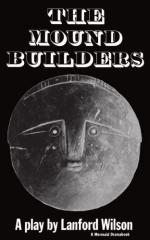[Illustration: FIGURE 2.]
(b.) Complete Pottery Cup. So far as I know this is the only complete cup now in existence in the region northwest of Lake Superior, though several others are said to have been discovered and been sent to distant friends of the finders. This cup, belonging now to the Historical Society was found in the grand mound, in company with charred bones, skulls, and other human bones, lumps of red ochre, and the shells just described. The dimensions of the cup are as follows:
Mean diameter at top of rim 2.09 inches. Greatest mean diameter 3.03 " Height 2.49 " Thickness of material 0.092 " Weight —— oz.
Whether the cup was intended for use as a burial urn, or simply for ordinary use it is difficult to say.
Now, in endeavoring to sum up the results a few points need some discussion.
1. Who were the people who erected the mounds? Judging from the following considerations, I should say they were
NOT AN INDIAN RACE.
Whoever built the mounds had a faculty not possessed by modern Indians. Building instincts seem hereditary. The beaver and the musk rat build a house. Other creatures to whom a dwelling might be serviceable, such as the squirrel, obtain shelter in another way. And races have their distinctive tendencies likewise. It never occurs to an Indian to build a mound. From what has been already said as to the fertile localities in which the mounds are found we are justified in believing that their builders were agriculturists. Dr. Dawson in Montreal by the use of the microscope detected grains of charred corn in the remains of Hochelaga. I have examined a small quantity of the dust taken from one of the shells found in the grand mound, with the microscope, and though I am not perfectly certain, yet I believe there are traces of some farinaceous substance to be seen. On skirting the shores of the Lake of the Woods into which Rainy River runs, at the present time, you are struck by the fact that there are no Canadian farmers there, and likewise that there are no mounds to be seen, while along the banks of Rainy River both the agriculturist is found cultivating the soil and the mounds abound. It would seem to justify us in concluding that the farmer and the mound builder avoided the one locality because of its barren rocky character, and took to the other because of its fertility. Moreover the continual occurrence of pottery in the mounds shows that the mound builders were potters as well, while none of the tribes inhabiting the district have any knowledge of the art of pottery. The making of pottery is the occupation peculiarly of a sedentary race, and hence of a race likely to be agriculturists. As it requires the building faculty to originate the mounds, so it requires the constructive faculty to make pottery. In constructive ability our Indians




